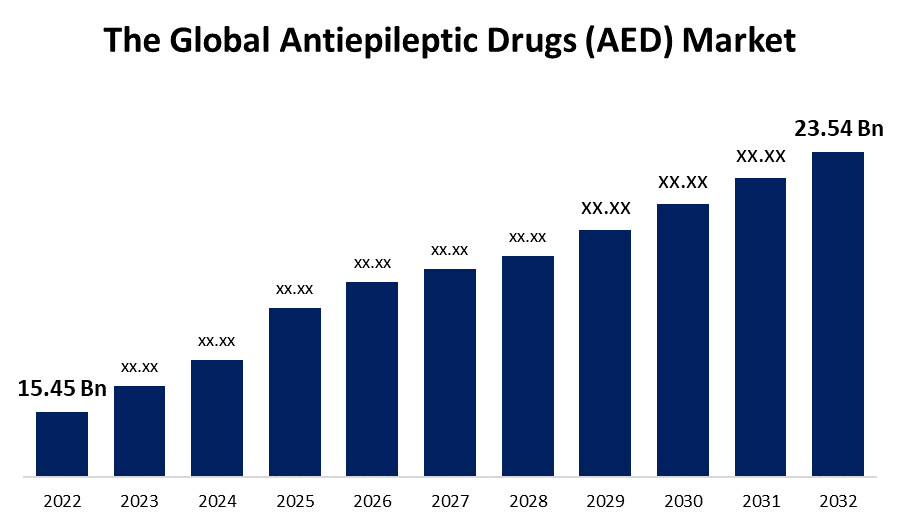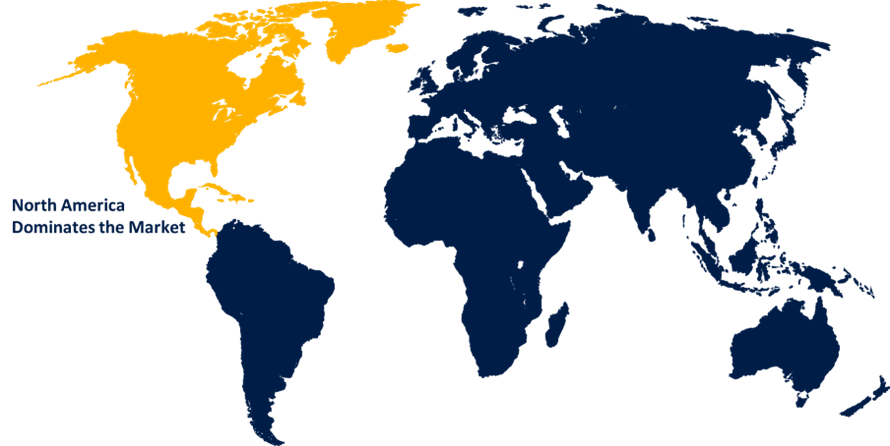Global Antiepileptic Drugs (AED) Market Size, Share, and COVID-19 Impact Analysis, By Drug Generation (First Generation, Second Generation, Third Generation), By Distribution Channel (Hospital Pharmacies, Retail Pharmacies, Online Pharmacies), By Route of Administration (Oral, Intravenous), and By Region (North America, Europe, Asia-Pacific, Latin America, Middle East, and Africa), Analysis and Forecast 2022 - 2032
Industry: HealthcareGlobal Antiepileptic Drugs (AED) Market Size Insights Forecasts to 2032
- The Global Antiepileptic Drugs (AED) Market Size was valued at USD 15.45 Billion in 2022.
- The Market Size is Growing at a CAGR of 4.3% from 2022 to 2032.
- The Worldwide Antiepileptic Drugs (AED) Market Size is expected to reach USD 23.54 Billion by 2032.
- Europe & Asia Pacific is expected to grow the fastest during the forecast period.

Get more details on this report -
The Global Antiepileptic Drugs (AED) Market Size is expected to reach USD 23.54 Billion by 2032, at a CAGR of 4.3% during the forecast period 2022 to 2032.
Epilepsy is one of the world's most common neurological diseases. Patients suffering from this disease experience abrupt behavioral changes, severe emotional distress, and loss of consciousness. More than 50 million people have epilepsy globally. This disease is a common severe brain disorder caused by a variety of factors that result in epileptic seizures. These drugs work by reducing the occurrence of abnormal and excessive electrical discharges in the brain, which leads to seizures. The rising prevalence of epilepsy places a significant economic burden on the world's healthcare systems. The market is expected to grow due to the high prevalence rate and growing demand for treatment options for this disorder.
Global Antiepileptic Drugs (AED) Market Report Coverage
| Report Coverage | Details |
|---|---|
| Base Year: | 2022 |
| Market Size in 2022: | USD 15.45 Billion |
| Forecast Period: | 2022-2032 |
| Forecast Period CAGR 2022-2032 : | 4.3% |
| 2032 Value Projection: | USD 23.54 Billion |
| Historical Data for: | 2020-2021 |
| No. of Pages: | 200 |
| Tables, Charts & Figures: | 115 |
| Segments covered: | By Drug Generation, By Distribution Channel, By Route of Administration, By Region. |
| Companies covered:: | Pfizer Inc., UCB S.A., Novartis, Dr. Reddy’s Laboratories, GSK plc., Mylan NV, Johnson & Johnson, AbbVie, H. Lundbeck A/S, Eisai Co., Ltd., Sanofi, Teva Pharmaceutical Industries, Sun Pharmaceutical, Sunovion Pharmaceuticals Inc., Jazz Pharmaceuticals, Inc., And Others. |
| Pitfalls & Challenges: | Covid-19 Empact,Challenges,Growth, Analysis. |
Get more details on this report -
Driving Factors
Product approvals for epileptic disorders will drive market growth during the forecast period. Despite the availability of AEDs on the market, drug intolerance affects one-third of the population. Manufacturers are making numerous efforts to mitigate this issue. R&D personnel are now concentrating on developing target-specific drugs for the disease's neurobiology. The rising prevalence of epilepsy, which requires therapeutically effective medications, puts market players under pressure to introduce AEDs. Moreover, government support and investments to accelerate market growth. Epilepsy is the most common neurological circumstance, and it is much more common in developing countries. The state affects a greater proportion of the population in developing countries such as India, China, and Brazil. Governments from around the world are stepping up their efforts to reduce the disease's impact and accelerate the availability of better treatment options.
Restraining Factors
The antiepileptic drugs market growth is hampered by a scarcity of antiepileptic drugs. Despite the rising prevalence of epilepsy, seizures, and other chronic conditions in developing countries, certain factors are impeding the growth of the global antiepileptic drug (AED) market. The sharp increase in medicine supply shortage and patients stockpiling these medications due to a drug shortage in pharmacies are the major factors hampering market growth during the forecast period.
Market Segmentation
By Drug Generation Insights
The second-generation segment is expected to hold the largest share of the global antiepileptic drugs (AED) market during the forecast period.
Based on the drug generation, the global antiepileptic drugs (AED) market is classified into first generation, second generation, and third generation. Among these, the second generation segment is expected to hold the largest share of the antiepileptic drugs (AED) market during the forecast period. The second-generation drugs include Lyrica, Keppra, Banzel, and others. Lyrica is the market leader in epilepsy treatment and has the largest market share. It has demonstrated the ability to slow brain impulses and control seizures. Lyrica, manufactured by Pfizer, dominated the epilepsy market. However, due to the drug's benefits, it is still in high demand.
By Distribution Channel Insights
The hospital pharmacies segment is witnessing significant CAGR growth over the forecast period.
Based on the distribution channel, the antiepileptic drugs (AED) market is segmented into hospital pharmacies, retail pharmacies, and online pharmacies. Among these, the hospital pharmacies segment grow at a significant CAGR growth over the forecast period. The segmental growth can be attributed to the rise of hospital pharmacies for neurology, as well as patient's preference for hospitals due to advanced infrastructure and adequate facilities. Furthermore, the growing number of hospitals and adequate reimbursement policies provided by these settings are significant factors contributing to an increase in the number of epilepsy patients being treated in these settings. This eventually led to the global adoption of antiepileptic drugs by hospital pharmacies.
By Route of Administration Insights
The oral segment is witnessing significant CAGR growth over the forecast period.
Based on the route of administration, the antiepileptic drugs (AED) market is segmented into oral and intravenous. Among these, the oral segment holds the significant CAGR growth over the forecast period. Antiepileptic drugs are frequently administered orally for the chronic treatment of epilepsy. Epilepsy therapy entails administering medications for both acute and chronic conditions in a variety of formulations.
Regional Insights
North America accounted for the highest market share over the forecast period.

Get more details on this report -
North America accounted for the highest market share over the forecast period. The North America market is distinguished by higher rates of neurology diagnosis and treatment, as well as adequate reimbursement policies for epilepsy drugs. These factors, along with increased patient awareness of new treatment options and the availability of advanced drugs in the region, are responsible for the region's dominant share of the global market. Furthermore, higher R&D investments are primarily promoted in order to maintain North American dominance.
The Europe and Asia Pacific antiepileptic drugs (AED) market is expected to record the fastest CAGR during the forecast period. The rising number of drugs receiving regulatory approval is expected to drive demand for anticonvulsant drugs in Europe over the forecast period. Expected regulatory approvals in the Asia Pacific, as well as the penetration of key regional players, are expected to drive the Asia Pacific regional antiepileptic drugs (AED) market revenue during the forecast period.
List of Key Market Players
- Pfizer Inc.
- UCB S.A.
- Novartis
- Dr. Reddy's Laboratories
- GSK plc.
- Mylan NV
- Johnson & Johnson
- AbbVie
- H. Lundbeck A/S
- Eisai Co., Ltd.
- Sanofi
- Teva Pharmaceutical Industries
- Sun Pharmaceutical
- Sunovion Pharmaceuticals Inc.
- Jazz Pharmaceuticals, Inc.
- Others
Key Market Developments
- In February 2022, Biohaven Pharmaceutical Holding Company Ltd. agreed to buy Channel Biosciences, LLC's Kv7 channel activators for target indications such as epilepsy, pain disorders, and affective disorders.
- In August 2021, UCB S.A. received FDA approval for an expanded indication for BRIVIACT (brivaracetam) CV tablets, injection, and oral solution. The product would aid in the treatment of partial-onset seizures in patients as young as one month old.
- In August 2021, The UK Competition and Markets Authority (CMA) fined Pfizer Inc. and Flynn Pharma USD 84 million for overcharging the NHS for a widely used epilepsy drug.
Market Segment
This study forecasts revenue at global, regional, and country levels from 2022 to 2032. Spherical Insights has segmented the global antiepileptic drugs (AED) market based on the below-mentioned segments:
Antiepileptic Drugs (AED) Market, Drug Generation Analysis
- First Generation
- Second Generation
- Third Generation
Antiepileptic Drugs (AED) Market, Distribution Channel Analysis
- Hospital Pharmacies
- Retail Pharmacies
- Online Pharmacies
Antiepileptic Drugs (AED) Market, Route of Administration Analysis
- Oral
- Intravenous
Antiepileptic Drugs (AED) Market, Regional Analysis
- North America
- US
- Canada
- Mexico
- Europe
- Germany
- UK
- France
- Italy
- Spain
- Russia
- Rest of Europe
- Asia Pacific
- China
- Japan
- India
- South Korea
- Australia
- Rest of Asia Pacific
- South America
- Brazil
- Argentina
- Rest of South America
- Middle East & Africa
- UAE
- Saudi Arabia
- Qatar
- South Africa
- Rest of the Middle East & Africa
Need help to buy this report?